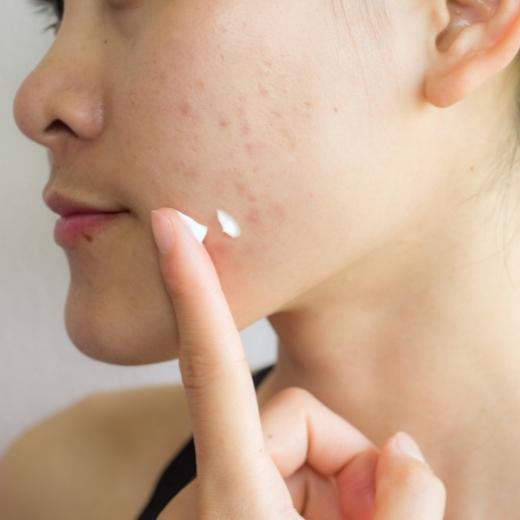Most Common Mistakes in Treating Adult Acne
Posted by Nikki Wisher on Apr 25th 2022
From one adult acne sufferer to another…I get it. It’s frustrating to say the least. Every time a new breakout happens, you feel like you’re transported back to your high school days of panicking over a giant zit popping up the day before prom.
Adult acne can be persistent and stubborn, but there is hope. In fact, clearer skin could be as simple as changing up a few of the strategies and habits you’re using in your daily life. Let’s take a look at some of the most common mistakes people make while self-treating adult acne. If any of these sound familiar, now is the time to learn and make a change.
Assuming Acne = Oily Skin
Acne is a more complicated condition than people give it credit for. There are many factors that can cause it or contribute to it. And yes, in teenagers, acne is most often caused by those puberty hormones causing their skin to produce excess oil, so evening out their oil production usually helps with acne. In adults, though, a natural excess of oil is less likely to be causing your acne.
Because of the misconception that acne means your skin is oily, many adults try to treat their acne by getting rid of as much oil as possible by using harsh cleansers or washing their skin too often. This can backfire by drying out your skin, and guess what happens when you have dry, flaky skin? The flakes clog your pores and a new breakout surfaces. Sometimes, when you over-dry your skin, your body will actually react by producing more oil, and that extra oil clogs your pores.
The real solution is to use a gentle, acne-centeredcleanser twice per day. Easing acne is about consistent care rather than aggressive care.
Overlooking Non-Skincare Healthy Habits
Your skin care routine isn’t the only factor that determines your acne breakouts. In fact, there are probably little things you’re doing on a daily basis that are contributing to the problem without you realizing it.
One important health habit to follow is to regularly (read: at least once weekly) wash your pillowcase. Even if you lay down every night with perfectly clean, fresh skin, there will be dirt and debris that collect on your pillowcase over time, and they can get into your pores when your face rests on them all night.
Another important habit is to regularly clean anything else that comes into contact with your face. Phones and glasses or sunglasses are some of the most common culprits, but anything that touches your face can accumulate dirt and bacteria that are just itching to fire up a fresh pimple. The worst offender is usually your own hands, though. Avoid touching your face when possible and wash your hands regularly throughout the day.
Skipping Moisturizer
Moisturizer has gotten a bad rap in the acne world. Yes, some moisturizers do contain oil and some do clog your pores. But remember that tip above: if your skin’s too dry, it can be a gateway for worsening acne. Moisturizer is your best tool for keeping your skin hydrated.
The trick is to use the right moisturizer. Choose an acne-friendly moisturizer you can safely use every day.
Misunderstanding the Relationship Between Sweating and Acne
Like moisturizer, sweat is vastly misunderstood in the context of acne. Many people believe that sweating will make acne worse, but it’s really a matter of how you care for your skin when you sweat.
Sweating can actually help with acne because it can push dirt and debris out of your pores, breaking up clogs in the making. Here’s the big caveat, though: it’s crucial to wash your face soon after your workout. If you don’t, your sweat (and the debris it pushed out of your pores) will sit on your skin and creep into your pores to form new breakouts.
Being Reactive Instead of Proactive
What’s better than stomping out a breakout quickly? Not having a breakout at all. Many people who struggle with acne have a yoyo-like experience, with a constant cycle of breakouts and periods of calm skin. This usually happens because you’re being reactive instead of proactive.
In other words, when you see a breakout, you start prioritizing your skin care: washing your face regularly, using acne-fighting products, and so on. Then, when the breakout is gone, you back off your skin care because the problem is gone.The truth is that acne symptoms can often be prevented by just continuing to follow a consistent, acne-friendly skin care regimen even while your skin is calm.
Using Non-Acne-Friendly Skin Care Products
As I mentioned, moisturizer is often blamed for breakouts, but the truth is that anything that touches your skin could have ingredients that are sparking acne. That’s why, not only while shopping for moisturizers but while shopping for any other skin care products too, you need to choose acne-friendly products. Most notably, look for the term “non-comedogenic” on the label, which means that the product doesn’t contain ingredients that are known to have a high risk for causing comedones (the fancy medical term for clogged pores). From facial serums to eye creams, non-comedogenic products will be your best friends.
Getting Your Adult Acne Under Control
All these tips might seem like a lot to do to manage your skin, but here’s the good news: in many cases, once you’ve found the right skin care regimen and lineup of products to suit you, you can likely keep your acne symptoms to a minimum for as long as you maintain that routine. Start with the tips above and get your skin on the right track!

